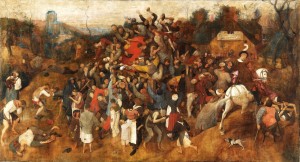A Medieval Where’s Waldo?
While at the Prado in Madrid, I was fortunate to see works by one of my favourite painters, Pieter Brueghel the Elder. Most notably, I saw The Wine of St. Martin’s Day Feast, identified quite recently as a work by Brueghel. In the painting people are crowded around an impossibly large wine cask, using anything they can get their hands on (including hats and shoes) to scoop out the first of the season’s product. In the bottom right corner of the painting is St. Martin of Tours, handing his cloak to a beggar. This famous figure and his generous action go unnoticed by the crowd, who are too busy falling over each other in their eagerness to get drunk.
Like many of Brueghel’s paintings, The Wine of St. Martin’s Day Feast depicts both ordinary peasant life, and an important event. In many paintings, like this one, the important event is historical (like St. Martin giving the cloak, the birth of Jesus, the crucifixion), but is treated as a contemporary occurrence. The hidden nature of the main subject is a common theme in many of Brueghel’s paintings, including The Census at Bethlehem, The Massacre of the Innocents, The Procession to Calvary, and Landscape with the Fall of Icarus. In many of these paintings, I would not have noticed the main subject if it were not for the title.
In these paintings, Brueghel does not show suffering or saints in the foreground, but hides them in the hustle and bustle of everyday life. Icarus (in Landscape with the fall of Icarus) is barely visible as a pair of legs in the bottom right hand corner of the painting. Similarly, the arrival of Mary and Joseph at Bethlehem (in The Census at Bethlehem) and the slaughter of children (Massacre of the Innocents) are not immediately perceived when looking at the paintings. Mary, Mary, and John are noticeable in the foreground of The Procession to Calvary, but it took me quite a while to find Jesus.
I have always loved Brueghel’s paintings, but never so much as when I discovered W. H. Auden’s poem Musée des Beaux Arts. Auden’s poem highlights the important point of Brueghel’s paintings that might be missed by the chance observer, and is reproduced in whole here:
About suffering they were never wrong,
The old Masters: how well they understood
Its human position: how it takes place
While someone else is eating or opening a window or just walking dully along;
How, when the aged are reverently, passionately waiting
For the miraculous birth, there always must be
Children who did not specially want it to happen, skating
On a pond at the edge of the wood:
They never forgot
That even the dreadful martyrdom must run its course
Anyhow in a corner, some untidy spot
Where the dogs go on with their doggy life and the torturer’s horse
Scratches its innocent behind on a tree.In Breughel’s Icarus, for instance: how everything turns away
Quite leisurely from the disaster; the ploughman may
Have heard the splash, the forsaken cry,
But for him it was not an important failure; the sun shone
As it had to on the white legs disappearing into the green
Water, and the expensive delicate ship that must have seen
Something amazing, a boy falling out of the sky,
Had somewhere to get to and sailed calmly on.
In a course on suffering, Edwin Hui explained that in our culture, we do our best to distance ourselves from all suffering, including our own.[1] This idea is not new; Plato first offered the doctrine of the irrelevance of suffering.[2] At first it may appear as if Brueghel and Auden do the same. But I disagree. I believe that they highlight and intensify our understanding of suffering through juxtaposition.
Auden’s poem mimics the style of Brueghel’s paintings, intersecting the significant events, like the miraculous birth and dreadful martyrdom, with sequences of mundane affairs. The contrast of such suffering with the quotidian enhances the tragic nature of the suffering. The style of the poem extends the reflection and offers a deeper perspective on the world. This is heightened by line 3, the only unrhymed line, about the “human position” and “how it takes place”. By isolating this sentence, the poem emphasizes this idea of the human position hidden in Brueghel’s paintings. In the same way that the line is hidden in its unrhymed state in the poem, Icarus, the innocents, Mary and Joseph, and Jesus are all ‘hidden’ (or at least not obvious) in Brueghel’s paintings. What is this human position? It is to be neglected. It is a life where sufferers and saints, where the heights of mythical hubris and the depths of divine humility, are overlooked.
Saints and Sufferers. Let us be vigilant lest we—busy with our own lives, blinded by our preoccupations and desires—let them pass by unnoticed.
[1] Edwin Hui, Course Lecture, February 26, 2013.
[2] John Ferguson, The Place of Suffering (London: James Clark & Co., 1972), 38.
Robyn
Latest posts by Robyn (see all)
- I’m A Man But I Can Change? Human Nature and Human Enhancement - December 12, 2016
- The Nicene Creed: “…to judge the quick and the dead…” - July 4, 2016
- Can Hermeneutics be Ethical? Ricoeur and the War - June 7, 2016

